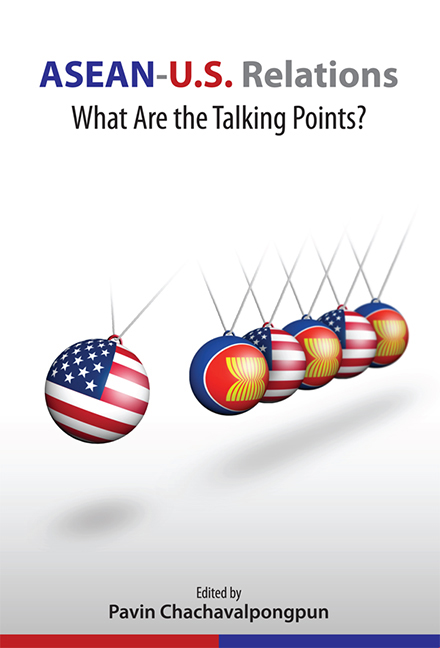Book contents
- Frontmatter
- Contents
- List of Tables and Figures
- Preface
- Contributors
- List of Abbreviations
- OVERVIEW
- QUINTESSENTIAL ISSUES
- 6 A New Era in the Long-Standing U.S.-ASEAN Relationship
- 7 Maritime Security in Southeast Asia and the United States
- 8 ASEAN's View on the U.S. Military Role in the Region
- 9 United States–China Relations
- 10 Shift in U.S. Policy towards Myanmar
- 11 United States Assistance to ASEAN through the ADVANCE Programme
- 12 Conclusion
- Index
8 - ASEAN's View on the U.S. Military Role in the Region
from QUINTESSENTIAL ISSUES
Published online by Cambridge University Press: 21 October 2015
- Frontmatter
- Contents
- List of Tables and Figures
- Preface
- Contributors
- List of Abbreviations
- OVERVIEW
- QUINTESSENTIAL ISSUES
- 6 A New Era in the Long-Standing U.S.-ASEAN Relationship
- 7 Maritime Security in Southeast Asia and the United States
- 8 ASEAN's View on the U.S. Military Role in the Region
- 9 United States–China Relations
- 10 Shift in U.S. Policy towards Myanmar
- 11 United States Assistance to ASEAN through the ADVANCE Programme
- 12 Conclusion
- Index
Summary
Southeast Asia, being strategically positioned in the region, stands at the confluence of great power rivalry and, at the same time, faces a multitude of non-traditional security challenges as well as residual intramural rivalries. The Barack Obama administration on its part adopts a moderate, fiscally-sustainable security approach and is regarded to continue roughly similar military involvement in Southeast Asia. Obama's policy also stresses multilateral cooperation and, in this regard, burden sharing. This is a welcome policy stance, but one that is also a cause for concern over the possible decline of the United States and its reduced commitment towards regional security. These concerns are largely unfounded. It is apparent that U.S. military commitments to the Asia-Pacific on the whole will remain consistent. This is illustrated in the professed intent by Washington to augment the U.S. Navy Seventh Fleet — the linchpin of American military power in the region — in apparent response to China's military rise and increased assertiveness, Korean Peninsula problems, and emerging non-traditional security (NTS) risks.
The basic foundations of the U.S. military role in Southeast Asia remain largely unchanged from the ones that existed under the Bush administration. However, U.S. military involvement may increasingly become issue focused, especially with regard to NTS risks. The Obama administration is focusing on NTS as the basis of sustainable military cooperation with ASEAN. This bodes well for capacity-constrained ASEAN. In the face of geopolitical uncertainties, ASEAN countries from the time of the Bush administration have been attempting to build up their own defence and security capacities. Intraregional defence and security cooperation also appear to have hastened, as seen in talks about the pooling together of nationallevel military capacities, primarily targeted at NTS issues, and ideas about formal military cooperation.
Other than intensifying efforts in regional security cooperation, ASEAN continues to adopt a “business as usual” hedging approach, particularly in the accumulation of national military capacities, especially force-projection assets. The inherent risk is that these capabilities might pose a classic security dilemma, especially given the outstanding territorial disagreements in the region. To sustain U.S.-ASEAN military relations, the United States should continue to fill niche roles by leveraging its power-projection capabilities, especially in NTS contingencies.
- Type
- Chapter
- Information
- ASEAN-U.S. RelationsWhat Are the Talking Points?, pp. 55 - 82Publisher: ISEAS–Yusof Ishak InstitutePrint publication year: 2011



